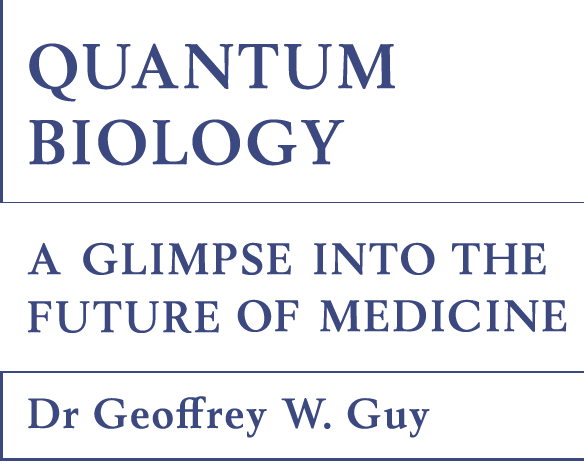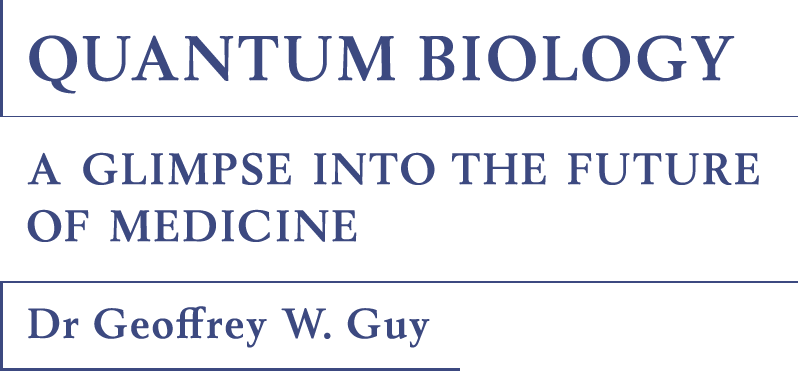
- About Geoffrey Guy
- List of chapters
- 1 Flatworms and xenobots
- 2 Beyond neurons: quantum effects in the brain
- 3 The ghost in the machine
- 4 Inflammation and equilibrium
- 5 The light fantastic
- 6 Lessons from the pandemic
- 7 Reassessing the causes of cancer
- 8 Energy, information and light
- 9 Before the origins of life
- 10 Unravelling the double helix
- 11 The computer in our cells
- 12 Space: the quantum frontier?
- 13 The quantum fractal
- 14 The path to mainstream
- Glossary
- Buy the book



7
Reassessing the causes of cancer
This page provides online resources relating to Chapter 7 of Quantum Biology: A Glimpse into the Future of Medicine. Read a chapter extract, or scroll down to access figures and terminology, additional resources published by The Guy Foundation, and a list of further reading.
Name of the Chapter
Subheading
All biological systems require a continuous energy supply to maintain their internal stability. They are also incredibly complex and need to be controlled and ordered. Electromagnetism seems to satisfy the necessary conditions for fast responses across a range of scales and the notion is supported by observations that the electromagnetic properties of cells and tissues are central to the ways they grow, develop different characteristics and organise themselves.
This approach is known as quantum field theory because it is based on the hypothesis that it is not genetics, but disruption to the body’s electromagnetic fields, which cause changes in the way cells grow and ultimately in the way that cancers take hold. Field theory sees cancer as originating with tissue regulation rather than cell mutation. These same fields may also provide new opportunities for the detection and treatment of cancer.
Buy the book here
A gap junction is essentially a bridge between two cells. Gap junctions are made up of specialised proteins. They appear in virtually all the tissues of the body, and they allow molecules, ions and – crucially – electrical impulses to pass across the gap between the interlinked cells.
Apoptosis is a method used by the body to dispose of unwanted or abnormal cells. It is sometimes called ‘programmed’ cell death, because the cell’s contents are carefully broken down for collection and reuse by the immune system.
The cell cycle is the series of changes that take place in a cell as it grows and divides. The cycle is essential for the growth, reproduction and repair of living organisms such as humans. For example, without the cell cycle, our bodies would not be able to repair damage caused by injury or illness
Cancer Meeting Proceedings
Quantum Biology and Cancer
January 2024
Read the proceedings here.
2022 Spring Series Proceedings
From quantum bench to bedside: Realising the potential of quantum biology in medicine
June 2022
Videos

The Guy Foundation 2022 Spring Series
Electromagnetic fields and cancer and the therapeutic perspective.
Dr Jan Pokorný, Academy of Sciences of the Czech Republic
Professor Steve Wedge, Newcastle University and Cancer Research UK (CRUK) Newcastle Drug Discovery Unit
Also visit The Guy Foundation YouTube Channel Mitochondria Playlist
See the Playlist.
Muneer Abbas and Philip Kurian, ‘Quantum probes in cancer research’, Nature Reviews Cancer 22 (2022), doi.org/10.1038/s41568-022-00465-2
David S. Baskin, Martyn A. Sharpe, Lisa Nguyen and Santosh A. Helekar, ‘Case report: end-stage recurrent glioblastoma treated with a new noninvasive non-contact oncomagnetic device’, Frontiers in Oncology 11 (2021), doi.org/10.3389/fonc.2021.708017
P. M. Biava, F. Burigana, R. Germano et al., ‘Stem cell differentiation stage factors and their role in triggering symmetry breaking processes during cancer development: a quantum field theory model for reprogramming cancer cells to healthy phenotypes’, Current Medicinal Chemistry 26:6 (2019), doi.org/10.2174/0929867324666170920142609
Joao Carvalho, ‘A bioelectric model of carcinogenesis, including propagation of cell membrane depolarization and reversal therapies’, Scientific Reports 11 (2021), doi.org/10.1038/s41598-021-92951-0
Lya G. Hernández, Harry van Steeg, Mirjam Luijten and Jan van Benthem, ‘Mechanisms of non-genotoxic carcinogens and importance of a weight of evidence approach’, Mutation Research 682:2–3 (2009), doi.org/10.1016/j.mrrev.2009.07.002
Morgan D. Kuczler, Athen M. Olseen, Kenneth J. Pienta and Sarah R. Amend, ‘ROS-induced cell cycle arrest as a mechanism of resistance in polyaneuploid cancer cells (PACCs)’, Progress in Biophysics and Molecular Biology 165 (2021), doi.org/10.1016/j.pbiomolbio.2021.05.002
P. Kurian and C. Verzegnassi, ‘Chirality-energy conversion induced by static magnetic effects on free electrons in quantum field theory’, Journal of Physics Communications 2:11 (2018), doi.org/10.1088/2399-6528/aae876
Michael Levin, ‘Bioelectrical approaches to cancer as a problem of the scaling of the cellular self’, Progress in Biophysics and Molecular Biology 165 (2021), doi.org/10.1016/j.pbiomolbio.2021.04.007
Angela Mally and James Kevin Chipman, ‘Non-genotoxic carcinogens: early effects on gap junctions, cell proliferation and apoptosis in the rat’, Toxicology 180:3 (2002), doi.org/10.1016/S0300-483X(02)00393-1
Noemi Monti, Roberto Verna, Aurora Piombarolo et al., ‘Paradoxical behavior of oncogenes undermines the somatic mutation theory’, Biomolecules 12:5 (2022), doi.org/10.3390/biom12050662
B. S. Oppenheimer, E.T. Oppenheimer, A. P. Stout and I. Danishefsky, ‘Malignant tumors resulting from embedding plastics in rodents’, Science 118 (1953), doi.org/10.1126/science.118.3063.305
Jiří Pokorný, Jan Pokorný and Jitka Kobilková, ‘Postulates on electromagnetic activity in biological systems and cancer’, Integrative Biology 5:12 (2013), doi.org/10.1039/C3IB40166A
Martyn A. Sharpe, David S. Baskin, Kumar Pichumani, Omkar B. Ijare and Santosh A. Helekar, ‘Rotating magnetic fields inhibit mitochondrial respiration, promote oxidative stress and produce loss of mitochondrial integrity in cancer cells’, Frontiers in Oncology 11 (2021), doi.org/10.3389/fonc.2021.768758
David L. Vaux, ‘In defense of the somatic mutation theory of cancer’, BioEssays 33:5 (2011), doi.org/10.1002/bies.201100022
Rogier Versteeg, ‘Tumours outside the mutation box’, Nature 506 (2014), doi.org/10.1038/nature13061
